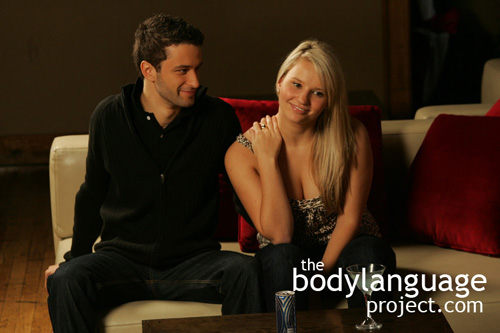Body Language of The Parade
Synonym(s): (the) Catwalk.
Description: The “parade” occurs when a woman walks with an exaggerated swinging or rolling of the hips, back arched, stomach flat, breasts protruding, and head held high.
In One Sentence: The parade is a way to showcase sexuality to others.
How To Use it: Women can use the parade most effectively. For men, this is called swagger. If women wish to be noticed for their sexual assets, they should swing their hips in full view others, especially the ones they wish would notice most. This can be done by walking, but equally, can be done by rolling the hips in a fixed position. Men find an exaggerated parade to be highly visible and difficult to ignore so women can effectively use it to solicit men.
Caution is in order when using the signal since the parade is considered a broadcast signal, and therefore, difficult to anchor to a specific person. In other words, the cue casts a ‘wide net’ potentially drawing in men of lesser quality. However, the cues’ strength relies on this by drawing in many potential “male orbiters” whom are ready to do perform various services for a shot at romance. Women therefore, can use the signal to solicit general attention and then simply refuse those advances which do not meet her criteria.
Context: Dating.
Verbal Translation: “My hips are the focal point of my sexuality so I’m swaying them hypnotically up and down to draw your attention to my sexual bits – I sure hope you notice!”
Variant: The hips are a source of great power in female sexuality. Any draw to the pelvis indicates a desire to showcase a woman’s virility for the admiration of others. A bare midriff is particularity alluring because it exaggerates the hip-to-waist ratio. Incidentally, the tight flat stomach is the first casualty of pregnancy, which reduces the hip-to-waist ratio significantly. For this reason, a bare midriff is normally always reserved for women in the pre-childbearing years of the late teens and early twenties or those in peek physical fitness.
The same effect is accomplished with skintight dresses, and also bikinis or adornments such as waistlets and belly button piercings. They serve to draw the eye to the relative difference between the hips and waist. See Hip Tilt.
Cue In Action: She was newly single and feeling positive. You could tell she was prowling because she appeared confident and vibrant. When she walked, she commanded attention and the boys couldn’t help but look. It was obvious by the way she pranced that she was available and advertising.
Meaning and/or Motivation: Women naturally have wider hips than men in order to accommodate childbirth and it is the exaggeration of the differences between men and women the makes them sexy.
The parade is a way for women to attract attention by emphasizing their hips. Studies show us that women out of committed relationship naturally walk in this manner to attract attention.
For this reason, runway models are also instructed to walk with a hip tilt but in a much more exaggerated way. The hip emphasis posture is pervasive in fashion and advertising. We see women slouching to one side forcing their hips out to emphasize their curves, or walking in an exaggerated way, bouncing their hips up and down as if on a pendulum. Their hips are seen swaying high from the left side, dropping, then right side, dropping.
Picturing this parade or “cat-walk” in the nude and you get the sense that there is an obviously hypnotic purpose to the method. Because the hips move about a center pivot, the eye is drawn front and center to the woman’s genitals – acting like a beacon.
Out of consciousness the parade is not overt or striking, but now that you understand the characteristics, you can watch for it. Women can also roll their hips while standing. This draws attention to their pelvic region.
Cue Cluster: The gesture might be accompanied by a sideways glance and slightly parted wet lips, which could be unconsciously exaggerated by saliva or lipstick.
Body Language Category: Amplifier, Courtship displays, Indicators of sexual interest (IOsI), Leaked or involuntary body language, Metronomic signals, Micromessaging.
Resources:
Abbey, A., and Melby, C. (1986). The effects of nonverbal cues on gender differences in perceptions of sexual intent. Sex Roles, 15, 283-298.
Buunk, B. P., & Dijkstra, P. K. (2005). A narrow waist versus broad shoulders: Sex and age differences in the jealousy-evoking characteristics of a rival’s body build. Personality and Individual Differences, 29, 379-389.
doi: 10.1016/j.paid.2005.01.020
http://bodylanguageproject.com/articles/adversarys-body-build-elicits-jealousy-men-women/
Book, Angela; Kimberly Costello and Joseph A. Camilleri Psychopathy and Victim Selection: The Use of Gait as a Cue to Vulnerability. Journal of Interpersonal Violence. 2013. 28(11): 2368-2383. DOI: 10.1177/0886260512475315jiv.sagepub.com
http://bodylanguageproject.com/articles/dont-walk-like-youre-watched-avoid-victimization-nonverbal-behavior/
Crossley, Kara L.; Piers L. Cornelissen and Martin J. Tovee. What Is an Attractive Body? Using an Interactive 3D Program to Create the Ideal Body for You and Your
Partner. PLOS one. November 2012. 7(11): e50601. doi:10.1371/journal.pone.0050601.g001
http://bodylanguageproject.com/articles/attractive-body-ideal-male-body-ideal-female-body-based-3d-morphing-study/
Crane, Elizabeth ; Gross, M. Effort-Shape Characteristics of Emotion-Related Body Movement. Journal of Nonverbal Behavior. 2013. 37(2): 91-105.
Cari D. Goetz; Judith A. Easton; David M.G. Lewis; David M. Buss. Sexual Exploitability: Observable Cues And Their Link To Sexual Attraction. Evolution and Human Behavior. 2012; 33: 417-426.
http://bodylanguageproject.com/articles/victim-blaming-or-useful-information-in-preventing-rape-and-sexual-exploitation/
Cho, S. H., Park, J. M., & Kwon, O. Y. (2004). Gender differences in three dimensional gait analysis data from 98 healthy Korean adults. Clinical Biomechanics, 19, 145–152.
Cutting, J. E., & Kozlowski, L. T. (1977). Recognizing friends by their walk: Gait
perception without familiarity cues. Bulletin of the Psychonomic Society, 9, 353–356.
Fink, Bernhard; Nadine Hugill and Benjamin P. Lange. Women’s Body Movements Are a Potential Cue to Ovulation. Personality and Individual Differences. 2012. 53: 759-763.
http://bodylanguageproject.com/articles/women-use-sexier-body-language-indicate-ovulation-fertility-women-dance-walk-sexier/
Furnham, Adrian ; Swami, Viren ; Shah, Krupa. Body weight, waist-to-hip ratio and breast size correlates of ratings of attractiveness and health. Personality and Individual Differences. 2006. 41(3): 443-454.
Fink, Bernhard; Nadine Hugill and Benjamin P. Lange. Women’s Body Movements Are a Potential Cue to Ovulation. Personality and Individual Differences. 2012. 53: 759-763.
http://bodylanguageproject.com/articles/women-use-sexier-body-language-indicate-ovulation-fertility-women-dance-walk-sexier/
Gunns, Rebekah E; Lucy Johnston; and Stephen M. Hudson. Victim Selection And Kinematics: A Point-Light Investigation Of Vulnerability To Attack. Journal of Nonverbal Behavior. 2002. 26(3): 129-158.
http://bodylanguageproject.com/articles/how-to-avoid-an-attack-just-by-changing-how-you-walk-study/
Guéguen, Nicholas. High Heels Increase Women’s Attractiveness. Archives of Sexual Behavior. 2014. DOI 10.1007/s10508-014-0422-z
http://bodylanguageproject.com/articles/high-heels-exact-power-men-study-women-wear-heels/
Guéguen Nicolas. Gait and menstrual cycle: ovulating women use sexier gaits and walk slowly ahead of men. Gait Posture. 2012; 35(4): 621-4.
http://bodylanguageproject.com/articles/gait-as-bait-women-walk-sexy-during-high-sexual-receptivity/
Guéguen N. Gait and menstrual cycle: ovulating women use sexier gaits and walk slowly ahead of men. Gait Posture. 2012; 35(4): 621-4.
http://bodylanguageproject.com/articles/gait-as-bait-women-walk-sexy-during-high-sexual-receptivity/
Givens D. The nonverbal basis of attraction: Flirtation, courtship, and seduction. Psychiatry. 1978. 41: 346.
Goetz, Cari D.; Judith A. Easton; David M.G. Lewis; David M. Buss. Sexual Exploitability: Observable Cues And Their Link To Sexual Attraction. Evolution and Human Behavior. 2012; 33: 417-426.
http://bodylanguageproject.com/articles/victim-blaming-or-useful-information-in-preventing-rape-and-sexual-exploitation/
Goetz, Cari D.; Judith A. Easton; Cindy M. Meston. The Allure of Vulnerability: Advertising Cues to Exploitability as a Signal of Sexual Accessibility. Personality and Individual Differences. 2013. 62: 121-125. http://dx.doi.org/10.1016/j.paid.2014.02.019
http://bodylanguageproject.com/articles/allure-sexual-vulnerability-move/
Hasegawa, T. and K. Sakaguchi. 2006. Person perception through gait information and target choice for sexual advances: comparison of likely targets in experiments and real life. Journal of Nonverbal Behavior 30(2): 63-85.
Hall, Jeffrey A. and Chong Xing. The Verbal and Nonverbal Correlates of the Five Flirting Styles. Journal of Nonverbal Behavior. 2015. 39:41–68. DOI 10.1007/s10919-014-0199-8
http://bodylanguageproject.com/articles/first-12-minutes-flirting-using-nonverbal-communication-study-reveals-26-body-language-cues-attraction/
Johnson, Kerri L.; Gill, Simone; Reichman, Victoria and Tassinary, Louis G. Swagger, Sway, and Sexuality: Judging Sexual Orientation from Body Motion and Morphology. Journal of Personality and Social Psychology. 2007. 93(3): 321-334. doi: 10.1037/0022-3514.93.3.321
http://bodylanguageproject.com/articles/heterosexual-vs-homosexual-swagger-can-you-spot-the-difference/
Kościński, Krzysztof. Assessment of Waist-to-Hip Ratio Attractiveness in Women: An Anthropometric Analysis of Digital Silhouettes. Archives of Sexual Behavior. 2014. 43(5): 989-997.
Kozlowski, L. T., & Cutting, J. E. (1977). Recognizing the sex of a walker from a dynamic point-light display. Perception and Psychophysics, 21, 575–580.
Miller, G., Tybur, J. M., & Jordan, B. D. Ovulatory cycle effects on tip earning by lap dancers: Economic evidence for human estrus. Evolution and Human Behavior. 2007. 28: 375-381. http://dx.doi.org/10.1016/j.evolhumbehav.2007.06.002.
Moore, Monica. Courtship Signaling and Adolescents: Girls Just Wanna Have Fun. Journal of Sex Research. 1995. 32(4): 319-328.
http://bodylanguageproject.com/articles/girls-just-want-to-have-fun-the-origins-of-courtship-cues-in-girls-and-women/
Moore, M. M. 2001. Flirting. In C. G. Waugh (Ed.) Let’s talk: A cognitive skills approach to interpersonal communication. Newark, Kendall-Hunt.
Moore, M. M. 1985. Nonverbal courtship patterns in women: context and consequences. Ethology and Sociobiology 64: 237-247.
Moore, M. M. and D. L. Butler. 1989. Predictive aspects of nonverbal courtship behavior in women. Semiotica 76(3/4): 205-215.
Moore, M. M. 1985. Nonverbal courtship patterns in women: context and consequences. Ethology and Sociobiology 64: 237-247.
Moore, Monica. Courtship Signaling and Adolescents: Girls Just Wanna Have Fun. Journal of Sex Research. 1995. 32(4): 319-328.
http://bodylanguageproject.com/articles/girls-just-want-to-have-fun-the-origins-of-courtship-cues-in-girls-and-women/
Miller, G., Tybur, J. M., & Jordan, B. D. Ovulatory cycle effects on tip earning by lap dancers: Economic evidence for human estrus. Evolution and Human Behavior. 2007. 28: 375-381. http://dx.doi.org/10.1016/j.evolhumbehav.2007.06.002.
Morris, Paul, H, Jenny White, Edward R. Morrison and Kayleigh Fisher. High Heels As Supernormal Stimuli: How Wearing High Heels Affects Judgements of Female Attractiveness. Evolution and Human Behavior. 2013. 34: 176-181.
http://bodylanguageproject.com/articles/high-heels-supernormal-body-language-signal/
Michalak, J., Rohde, K., Troje, N. F. How We Walk Affects What We Remember: Gait Modifications Through Biofeedback Change Negative Affective Memory Bias. Journal of Behavior Therapy and Experimental Psychiatry. 2015. 46:121-125.
http://bodylanguageproject.com/articles/walking-happy-leads-actual-happiness-game-emotions-body-language/
Opila-Correia, K. A. (1990). Kinematics of high-heeled gait. Archives of Physical Medicine and Rehabilitation, 71, 304–309.
Paul H. Morris, Jenny White, Edward R. Morrison and Kayleigh Fisher. High Heels As Supernormal Stimuli: How Wearing High Heels Affects Judgements of Female Attractiveness. Evolution and Human Behavior. 2013. 34: 176-181.
http://bodylanguageproject.com/articles/high-heels-supernormal-body-language-signal/
Roether, C. L., Omlor, L., Christensen, A., & Giese, M. A. (2009). Critical features for the perception of emotion from gait. Journal of Vision, 9(6), 1–32. http://dx.doi.org/10.1167/9.6.15.
Riling, James K.; Torrey L. Kaufmana; E.O. Smitha; Rajan Patele and Carol M. Worthmana. Abdominal Depth and Waist Circumference as Influential Determinants of Human Female Attractiveness. Evolution and Human Behavior. 2009. 30:21-31.
http://bodylanguageproject.com/articles/what-matters-most-in-womens-bodies-apparently-abdominal-depth-study/
Sakaguchi, Kikue and Toshikazu Hasegawa. Person Perception Through Gait Information And Target Choice For Sexual Advances: Comparison Of Likely Targets In Experiments And Real Life. Journal of Nonverbal Behavior. 2006; 30:63-85. DOI 10.1007/s10919-006-0006-2
http://bodylanguageproject.com/articles/dont-walk-like-youre-asking-targets-sexual-approach-based-walking-style-personality-study/
Schneider, Sabrina ; Christensen, Andrea ; Hau[sz]inger, Florian B. ; Fallgatter, Andreas J. ; Giese, Martin A. ; Ehlis, Ann – Christine. Show me how you walk and I tell you how you feel — A functional near-infrared spectroscopy study on emotion perception based on human gait. Neuroimage. 2014. 85: 380(11).
Sakaguchi, Kikue and Toshikazu Hasegawa. Person Perception Through Gait Information And Target Choice For Sexual Advances: Comparison Of Likely Targets In Experiments And Real Life. Journal of Nonverbal Behavior. 2006; 30:63-85. DOI 10.1007/s10919-006-0006-2
http://bodylanguageproject.com/articles/dont-walk-like-youre-asking-targets-sexual-approach-based-walking-style-personality-study/
Smith, E. O. (1999). High heels and evolution: Natural selection, sexual selection and
high heels. Psychology, Evolution and Gender, 30, 245–277. Smith, E. O., & Helms, W. S. (1999). Natural selection and high heels. Foot and Ankle International, 20, 55–57.
Smith, Finlay G.; Benedict C. Jones; Lisa L.W. Welling; Anthony C. Little; Jovana Vukovic; Julie C. Main and Lisa M. DeBruine. Waist–Hip Ratio Predicts Women’s Preferences for Masculine Male Faces, But Not Perceptions of Men’s Trustworthiness. Personality and Individual Differences. 2009. 47: 476-480.
http://bodylanguageproject.com/articles/low-waist-hip-ratio-predicts-female-desire-male-masculinity-study/
Singh, Devendra ; Randall, Patrick K. Beauty is in the eye of the plastic surgeon: Waist–hip ratio (WHR) and women’s attractiveness. Personality and Individual Differences. 2007. 43(2): 329-340.
Singh, Devendra. Is thin really beautiful and good? Relationship between waist-to-hip ratio (WHR) and female attractiveness. Personality and Individual Differences. 1994. 16(1): 123-132.
Singh, Devendra ; Dixson, B.J. ; Jessop, T.S. ; Morgan, B. ; Dixson, A.F. Cross-cultural consensus for waist–hip ratio and women’s attractiveness. Evolution and Human Behavior. 2010. 31(3): 176-181.
Sorokowski, Piotr ; Kościński, Krzysztof ; Sorokowska, Agnieszka ; Huanca, Tomas ; Sueur, Cédric. Preference for Women’s Body Mass and Waist-to-Hip Ratio in Tsimane’ Men of the Bolivian Amazon: Biological and Cultural Determinants. PLoS ONE. 2014. 9(8).
Streeter, Sybil A ; McBurney, Donald H. Waist–hip ratio and attractiveness: New evidence and a critique of “a critical test”. Evolution and Human Behavior. 2003. 24(2):.88-98.
Thoresen, John C.; Quoc C. Vuong and Anthony P. Atkinson. First Impressions: Gait Cues Drive Reliable Trait Judgements. Cognition. 2012. 261–271 Thoresen, John C.; Quoc C. Vuong and Anthony P. Atkinson. First Impressions: Gait Cues Drive Reliable Trait Judgements. Cognition. 2012. 261–271
http://bodylanguageproject.com/articles/walk-drives-first-impressions/
van der Zwan, Rick and Natasha Herbert. “I Like The Way You Move”: How Hormonal Changes Across The Menstrual Cycle Affect Female Perceptions of Gait. Research Notes. 2012; 5: 453.
http://bodylanguageproject.com/articles/women-at-peak-fertility-rate-other-female-walkers-less-favorably/
Walter, K. D., Brownlow, S., Ervin, S. L., & Williamson, N. (1998). Something in the way she moves: The influence of shoe altered gait on motion and trait impressions of women. PSI CHI Journal of Undergraduate Research, 3, 163–169.














